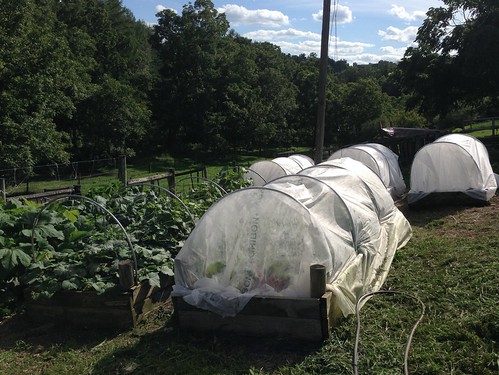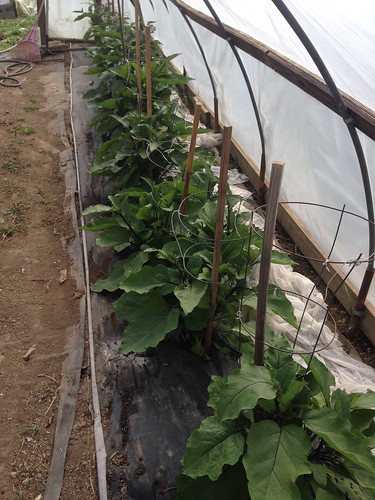
A hoop house on Tamarack Farm in Spring Mills, PA.
Perhaps there is such a thing as too much of a good thing. Many farmers in central Pennsylvania would aptly agree to this notion after experiencing above average amounts of rainfall this summer. In fact, rainfall during June and July in central Pennsylvania was more than four inches above average. The high summer temperatures coupled with these increased wet conditions quickly produced ideal habitats for many plant borne diseases. One disease in particular that inflicted dramatic damage upon many local farmers this past summer was late blight. One may recall that this was the plant disease responsible for the Irish Potato Famine back in the mid-nineteenth century. In memory of this historical event, late blight is nothing to take lightly.
Late blight is not like other potato or tomato diseases. Most other plant diseases might only affect the leaves or cause minor damage to the fruit/vegetable, but late blight will completely ruin an entire crop. Back in 2011, Michael Arthur, co-owner of Tamarack Farm with his wife, Jan Jenkins (to whom he says, “is the real driver of our farm”), in Spring Mills, PA lost nearly 90% of their tomatoes in a single night due to late blight. Its’ scientific name, phytophthora infestans, aptly translates to mean ‘plant destroyer.’ The disease reproduces quickly; especially at night when the temperature rests between 60-75°F degrees, and leaves are wet from rain, dew, or fog. The outbreak will then spread quickly under the right conditions as wind-dispersed spores can move several miles. To illustrate how fast late blight can travel, Eric Noel, owner of Eden View Farm located in Warriors Mark, PA says that often a farmer about two miles to his West will tell him he has found late blight on his tomatoes. Two days later, Noel will see it show up on his tomato plants. Then two days after that, a farmer to Noel’s East will see late blight bloom. Typically once five to ten percent of a crop becomes infected, the damage is already done because it is near impossible to halt the disease.
Noel has been fighting both early and late blight this season. Knowing that blight thrives off of wet conditions, he aligned his planting so that prevailing winds could blow through plants to better aerate them and keep everything as dry as possible. Noel also utilized copper sulfate and Epson salts as pre-season treatments. However, despite these efforts, he still had to resort to non-organic control in order to keep his tomatoes alive. In his twelve years of farming, this has been the first time he has ever been faced with the decision to use non-organic fungicides. Unfortunately, most of the restaurants that buy from him want only organically grown produce, and he now posts a big sign at his farm stand informing buyers that his tomatoes have been sprayed. “A little bit of income is better than no income from my tomatoes,” laments Noel.

Inside a hoop house on Tamarack Farm in Spring Mills, PA.
Arthur on the other hand reports that he has only had issues with early blight this summer. Although most of his tomato plants are open cultivation, Arthur has been able to avoid insecticide spraying through the use of both agribon fabric and a high tunnel. These tools have not only worked to help protect his vegetable crops from insect predation and plant diseases, but they will also allow Arthur to continue his tomato and eggplant productions late into the season.
In order to better understand why this summer has been so favorable to both early and late, one has only to look at the recorded weather data for the area. In June, only nine out of the thirty days in central Pennsylvania were dry, with the other twenty-one days recording precipitation events. Near the beginning of July, the area then experienced seven consecutive days of rain. In addition to all the rain, moderate temperatures ranging in the mid to upper 70s also helped provide more than ripe conditions for late blight to flourish. In all his years of farming, Noel notes that this summer has been the worst season of late blight that he has ever seen. Unfortunately, only time will tell if this is a cycle that will repeat periodically or if this disease will keep getting worse as the climate becomes more favorable for late blight. If it does, local weather data, real-time disease updates, and innovative planting practices will prove vital to the success of central Pennsylvania’s potato and tomato yields.
No comments:
Post a Comment
Note: Only a member of this blog may post a comment.